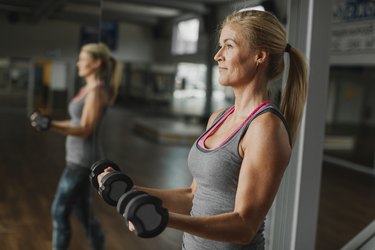
Strengthening exercises for women over 58 provide many benefits, including strengthening bones and slowing aging and muscle loss. Women in their fifties should add strength training to their routines to help maintain muscle tone and bone density.
Weightlifting for Older Women
Video of the Day
As you age, you start to naturally lose muscle strength and mass. According to Harvard Health Publishing, you will start to lose muscle strength around the age of 30. This is particularly true if your lifestyle is sedentary. Strengthening exercises (lifting and resistance training) help to prevent loss of strength, which can allow you to engage in more activities as you age. Other benefits of strength training for women include the following:
Video of the Day
- Improves mobility, balance and coordination, which may help prevent injury
- Helps promote cognitive health
- Improves mood
- Increases bone strength
- Decreases body fat
According to the Mayo Clinic, strength training helps improve symptoms of chronic illness. In addition, a study published in Frontiers in Physiology in June 2019 found that strength training helps prevent several chronic age-related illnesses.
If you are new to strength training, you should take it slowly. Doing too much too soon can result in injury that can take time to recover. If you have never participated in strength-training exercises and routines, you may want to consider talking to a personal trainer or following a routine from a certified trainer to help get you started.
Best Muscle-Strengthening Exercises
If you have never attempted strength training, it can be overwhelming at first. Most gyms are packed full of large, complicated machines, a range of free weights and often young enthusiasts who may be lifting more than you weigh.
But don't let intimidation stop you from starting a strength-training routine. There are many exercises you can do, regardless of age, both at home and at your local gym.
Read more: 8 Reasons Why Women Should Lift Weights
According to an exercise manual that the County of Los Angeles released, an older person should warm up their muscles prior to lifting. To do this, the manual recommends either walking, marching in place or cycling. In addition, the manual recommends the following upper-body exercises for older individuals:
- Seated lateral raises
- Chest presses
- Shoulder shrugs
- Biceps curls
- One-arm triceps raises
- One-arm rows
- Abdominal crunches
You can do these in any order you prefer. Most of them you can do in a seated position, on either a chair or a bench.
In addition to your upper body, you will need to do resistance training to help develop your lower body as well. Some exercises for the lower body include:
- Heel raises
- Leg extensions
- Body-weight squats
- Hamstrings curls
- Glute bridges
It is important that you start off at your level and concentrate first on form. You should pick a weight that you can lift between 10 and 12 times during a set.
If you are new to exercise, you may want to pick one or two exercise routines in each group. As you get comfortable, you can add additional exercises to your strength-training routine. The American Council on Exercise (ACE) recommends that you avoid certain strength-training activities, including exercises that require the following:
- Static poses
- Balanced poses
- Quick movements
- Use of excessive weight
- Reaching overhead
ACE also recommends that you may want to consider using exercise machines at the gym. Exercise machines add stability, and stability can help you avoid injury to your muscles and joints.
- Harvard Health Publishing: "Preserve Your Muscle Mass"
- Mayo Clinic: "Exercise and Chronic Disease: Get the Facts"
- Frontiers in Physiology: "Resistance Exercise Training as a Primary Countermeasure to Age-Related Chronic Disease"
- County of Los Angeles: "Exercise for Older Adults"
- American Council on Exercise: "The Basics of Training Older Adults"
- American Council on Exercise: "Turn Back the Clock: How to Maximize the Anti-Aging Benefits of Exercise"